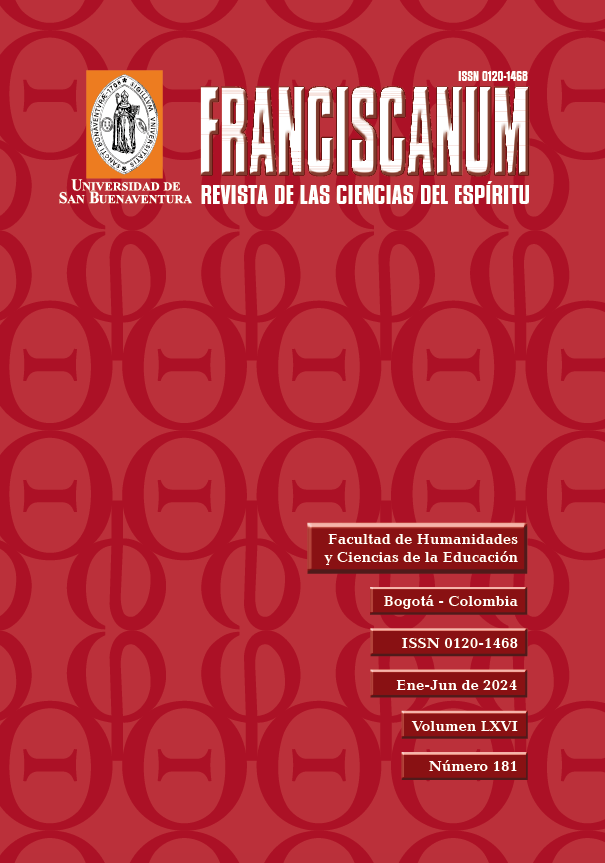This journal provides immediate open access to its content, based on the principle that giving the public free access to research helps a greater global exchange of knowledge.
Therefore, the Creative Commons 4.0 Attribution Attribution - Equal Share (by-sa) License is accepted: The commercial use of the work and the possible derived works is permitted, the distribution of which must be done with a license equal to that regulates the original work.
http://creativecommons.org/licenses/by-sa/4.0/
Along these same lines and in line with the Open Access policy, it is clarified that the authors maintain their rights to articles, without restrictions and, in the same way, they maintain their publication rights, without restrictions. They are only asked to reference the number of the Franciscanum magazine where the article initially appeared.
Abstract
This article studies the development and nature of the metaphors concerning the death of Jesus that appear in the Gospel of Mark and in the New Testament in order to make a literary contribution to the theological constructions that are based on this belief. It starts from the theory of metaphor offered by philosophers such as Paul Ricoeur and Friedrich Nietzsche and compares it with the findings of exegetes in recent years, such as Sharyn Dowd and Elizabeth Struthes Malbon, and the historical-exegetical discussions represented by Gerd Theissen, Jörg Frey, Jens Schröter and Ruben Zimmermann, as well as the contributions of recent interpreters from the German academy such as Marlis Gielen, Annette Merz and Angelika Strotmann. From a hermeneutic-literary point of view, the most known metaphors around the death of Christ, such as atonement, substitutionary death and sacrifice, are discussed and contrasted with the significant openness offered by the Gospels for an interpretation that attends to the poetic vitality of the biblical texts before the conformation of doctrines as belief systems.
References
Brown, Raymond. Introducción a la cristología del Nuevo Testamento. Salamanca: Sígueme, 2001.
Brown, Raymond. The Death of the Messiah. From Gethsemane to the Grave: A Commentary to the Passion Narratives in the Four Gospels I/II. New York: Doubleday, 1994.
Casas Ramírez, J.A. “El silencio y el conflicto en el Evangelio de Marcos. Propuestas de lectura desde el conflicto colombiano”. Revista Bíblica. No. 82, 2020, 123-142.
Dowd, Sharyn y Malbon, Elizabeth Struthes, “The Significance of Jesus’ Death in Mark: Narrative Context and Authorial Audience”. Journal of Biblical Literature, 125, No. 2, 2006, 271-297.
Frey, Jörg. “Probleme der Deutung des Todes Jesu in der neutestamentlichen Wissenschaft. Schrifftlicher zur exegestischen Diskussion”. Deutungen des Todes Jesu im Neuen Testament. Editado por Jörg Frey y Jens Schröter. Tübingen: Mohr Siebeck, 2012, 3-52.
Gebara, Ivone. Antropología religiosa: lenguaje y mitos. Buenos Aires: Católicas por el derecho a decidir, 2005.
Gielen, Marlis. Die Passionserzählung in den vier Evangelien. Literarische Gestaltung – theologische Schwerpunkte. Stuttgart: Verlag W. Kohlhammer, 2008.
González, Justo L. Historia del cristianismo. Tomo I. Desde la era de los mártires hasta la era de los sueños frustrados. Miami, Unilit, 1994
Gourges, Michel. Jesús ante su pasión y su muerte. Estella (Navarra): Verbo Divino, 1982.
Londoño, Juan Esteban. “La poesía y la cruz: interpretaciones literarias de la muerte de Cristo”. Aportes Bíblicos 33, 2019.
Nietzsche, Friedrich. „Ueber Wahrheit und Lüge im aussermoralischen Sinne“ (1873). Digital version of the German critical edition of the complete works of Nietzsche edited by Giorgio Colli and Mazzino Montinari. Disponible en: http://www.nietzschesource.org/#eKGWB/WL (consulta: 25/10/2022).
Pikaza, Xabier. Pan, Casa, Palabra. La iglesia en Marcos. Salamanca: Sígueme, 1998.
Richter Reimer, Ivoni. “¡No se Atemoricen!” (Mc 16,6). Visión General y Perspectivas Interpretativas”. Visión General y Perspectivas Interpretativas”. RIBLA (Revista de Interpretación Bíblica Latinoamericana), No 64. El Evangelio según Marcos, 2008/3, 7-21.
Ricoeur, Paul. La metáfora viva. Madrid: Ediciones Europa, 1980.
Schiavo, Luigi y Da Silva, Valmor. “Hipótesis interpretativas de los milagros en Marcos”. RIBLA (Revista de Interpretación Bíblica Latinoamericana), No 64. El Evangelio según Marcos, 2008/3, 57-65.
Schröter, Jens, “Sühne, Stellvertregunt und Opfer. Zur Verwendung analytischer Kategorien zur Deutung des Todes Jesu”. Deutungen des Todes Jesu im Neuen Testament. Editado por Jörg Frey y Jens Schröter. Tübingen: Mohr Siebeck, 2012, 51-72.
Strotmann, Angelika. Der historische Jesus. Paderborn: Ferdinand Schöning, 2015.
Tamez, Elsa, “The Conflict in Mark: A Reading from the Armed Conflict in Colombia”. Wilkinson, Nicole; Okure, Teresa; Patte, Daniel (Eds.). Mark. Texts and Contexts. Minneapolis: Fortress Press, 2011, 101-125.
Theissen, Gerd. La redacción socioeclesial de los evangelios y la política oficial. Estella: Verbo Divino, 2002.
Theissen, Gerd. Colorido local: contexto histórico en los evangelios. Una contribución a la historia de la tradición sinóptica. Salamanca: Sígueme, 1997.
Theissen, Gerd y Merz, Annette. Der historische Jesus. Göttingen: Vandenhoeck und Ruprecht, 2011.
Trebolle Barrera, Julio. La Biblia judía y la Biblia cristiana. Madrid: Trotta: 1998.
Zimmermann, Ruben. “Deuten heißt erzählen und übertragen. Narrativität und Metaphorik als zentrale Sprachformen historischer Sinnbildung zum Tod Jesu”. Deutungen des Todes Jesu im Neuen Testament. Editado por Jörg Frey y Jens Schröter. Tübingen: Mohr Siebeck, 2012, 315-374.

 Perfil Google Scholar
Perfil Google Scholar


















